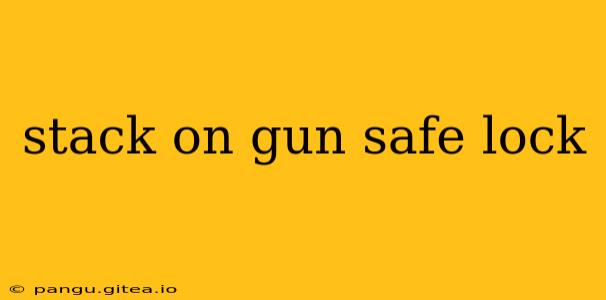Stack-On gun safes are a popular choice for firearm storage due to their affordability and accessibility. However, understanding the locking mechanisms and potential issues is crucial for ensuring both security and safe operation. This guide delves into the various lock types found in Stack-On safes, troubleshooting common problems, and providing tips for maintaining optimal performance.
Types of Stack-On Gun Safe Locks
Stack-On safes utilize a variety of locking systems, each with its strengths and weaknesses. The most common include:
1. Keypad Locks:
These electronic locks offer convenience, eliminating the need for keys. They typically use a combination of numbers entered on a keypad to unlock. While convenient, keypad locks can be vulnerable to brute-force attacks if the code is easily guessable or the safe lacks sufficient security features. Some models offer features like delayed time locks or tamper alerts, enhancing security.
Pros: Convenient, keyless entry.
Cons: Susceptible to brute-force attacks if a weak code is used, potential battery issues.
2. Key Locks:
Traditional key locks provide a straightforward and reliable method of securing your firearms. Their simplicity often translates to robustness, making them less susceptible to electronic malfunctions. However, lost or stolen keys can be a major inconvenience.
Pros: Simple, reliable, low maintenance.
Cons: Requires a physical key, potential for key loss or theft.
3. Combination Locks:
Similar to keypad locks, combination locks require a specific sequence of numbers to unlock. However, these use a dial instead of a keypad. This type of lock can be more resistant to brute-force attacks than keypad locks due to the physical manipulation required.
Pros: Resistant to electronic failures, generally more secure than keypads against brute-force attacks.
Cons: Can be slower to operate than electronic locks, requires memorization of the combination.
Troubleshooting Common Stack-On Gun Safe Lock Problems
Even the most robust locks can encounter issues. Here's a breakdown of common problems and potential solutions:
1. Keypad Lock Malfunctions:
- Dead Batteries: This is the most frequent cause. Replace the batteries (following the manufacturer's instructions) to resolve the issue.
- Incorrect Code Entry: Double-check the entered code carefully. Too many incorrect attempts might trigger a lockout feature; refer to your manual for instructions on resetting the code.
- Faulty Keypad: If batteries are fresh and the code is correct, the keypad itself might be malfunctioning. Contact Stack-On customer service or a qualified locksmith for assistance.
2. Key Lock Issues:
- Broken Key: Attempting to force a broken key into the lock can damage the mechanism. Contact a locksmith for key extraction and repair.
- Stuck Lock: Lubricating the lock mechanism with a specialized lock lubricant can often resolve sticking issues. However, avoid using excessive force.
3. Combination Lock Problems:
- Forgotten Combination: Unfortunately, if you forget the combination to your Stack-On gun safe, you'll likely need professional assistance from a locksmith to open it. This highlights the importance of keeping your combination in a safe and accessible place.
Maintaining Your Stack-On Gun Safe Lock
Regular maintenance is key to ensuring the longevity and reliability of your safe's locking mechanism:
- Regularly Inspect the Lock: Periodically check for any signs of damage, wear, or loose parts.
- Clean the Lock: Remove dust and debris around the lock mechanism with a soft brush or compressed air.
- Lubricate the Lock: Apply a small amount of lock lubricant to the moving parts as needed (especially for key and combination locks).
Security Considerations Beyond the Lock
While the lock is crucial, remember that the overall security of your Stack-On gun safe depends on more than just the locking mechanism. Consider these factors:
- Safe Placement: Secure the safe to the floor or wall for added protection against theft.
- Fire Protection: Choose a fire-resistant safe to protect your firearms from damage in case of a fire.
By understanding the various lock types available, troubleshooting common problems, and performing regular maintenance, you can significantly improve the security and lifespan of your Stack-On gun safe. Remember that professional help may be needed in some instances, especially for complex issues or forgotten combinations. Always prioritize firearm safety and secure storage.
